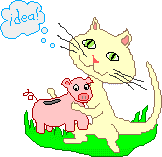





 |
 |
 |
 |
 |
 |
 return to the Idea Bank index |
(Share your ideas, too!)
|
| Online Resources for Connecting Math and Children's Books
Here are some good resources recommended in the November 2004 News Bulletin of the NCTM:
How to Use Children's Literature to Teach Mathematics
Mathematics and Children's Literature
Mathematics and Children's Literature (links)
Draw a Math Story: From the Concrete to the Symbolic |
| Resource Books for Teachers These books are available online through Amazon or NCTM. NCTM phone orders may be placed through (800) 235-7566, or use the links to specific resources below.
Exploring Mathematics through Literature: Articles and Lessons for Prekindergarten through Grade 8
New Visions for Linking Literature and Mathematics
The Wonderful World of Mathematics (Second Edition, 1998)
Math Is Language Too: Talking and Writing in the Mathematics Classroom |
| Math Literature, Anyone?
> What literature do you use with math? For which concept?
Well, this is a pretty broad concept....but, for instance, I
like the book Gator Pie is a great book to teach fractions - [in a newly-released 2005 interactive edition available only at www.bigstory.us ].
Debbie B., 8/18/00, on teachers.net math board
- - - - -
You will find literature here for the following topics!!!!!
Numeration Fractions
http://www.geocities.com/teachingwithheart/mathproductpage.html
Colleen:)/k-3, 8/19/00 on teachers.net math board
- - - - -
You can use this great book:
Sir Cumference and the First Round Table, by Wayne Geehan, illustrated by Cindy Neuschwander
Gisele, 8/19/00 on teachers.net math board
|
| Math Literature and Graphing Activities
> I will soon be a student teacher. In my method class for
Your thoughts are well thought out...
KathyB/1st/IA, 10/26/00 on teachers.net math board
- - - - -
Best of luck when you present your lesson. I'd like to suggest
some further ideas in a different format which you may or may
not find helpful.
Integrating math with Harriet means not only sorting and graphing,
which is good, but also how can you tie the feelings of
selfishness and greediness into your lesson, which I believe is
the lesson Nancy Carlson wants the reader to explore.
Here's an idea:
Choose the attributes you want the students to work with (i.e.
size, color, shape, etc.) and fill the bags with any and
everything (not just candy) that can be sorted like this. (As
candy is expensive, not very reusable, would probably take some
of your young students off task just thinking about eating it,
you might use different macaronis, shell beans, attribute or
fraction blocks, some hard/soft candies with,w/out wrappers,
paper clips, marbles, etc. -- the more creative the better!) Be
careful that what you put in bags can easily be sorted into the
attributes you work with in your lesson: you may only want to
focus on size and color, for example, and fill as many bags as
you have students. Put these bags into larger bags so that
you end up with one huge bag!
Hand this bag to one person - what do others think? I'm sure
you'll hear, "That's not fair;" talk about why and what would be
fair. Also, tell that one person that s/he will have to do all
of the work. Discuss briefly and then go on to give everyone
their own bags.
Go on to sort, graph, diagram (using rope circles on the floor
works good and working in groups helps).
Then read the book, drawing on students' experiences and how
they felt when doing the math lesson and tie it with Harriet
and her brother's feelings, summing up similarities/differences.
Extensions:
I don't know what timeframe you have, but this is something
that can go the whole morning/day, tying it all together
through many subject areas. I hope this gives you a few more ideas.
Good luck, em, 10/27/00 on teachers.net math board
|
| Animal Math Literature for Younger Children
> Any ideas for math lessons that also teach children
I Went Walking by Sue Williams
Both talk about farm animals. The second one is about farm
animal babies and counting numbers. Then you could create
your own versions by getting into other animals and their
babies. These books might help.
Over in the Meadow has many variations:
Over in the Meadow (Voyager Book) by John Langstaff, Feodor Rojankosky (Illustrator)
Other great versions and related titles:
Over in the Meadow: An Old Nursery Counting Rhyme (Books for Young Readers) by Paul Galdone, Jack Galdone
Over in the Meadow (Picture Books) by Ezra Jack Keats
Earthsong: Based on the Popular Song "Over in the Endangered Meadow"
Frog Went A-Courtin' by John Langstaff, Feodor Rojankovsky(Illustrator)
Oh, A-Hunting We Will Go by John Langstaff, Nancy W. Parker (Illustrator)
Over the Steamy Swamp by Paul Geraghty. Paperback (March 1995)
KathyB/1st/IA, 10/22/00, on teachers.net primary elementary board
|
|
|
| © copyright 2000 - Wendy Petti of Math Cats. All Rights Reserved. |